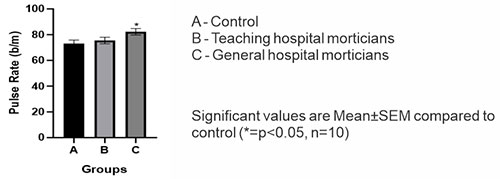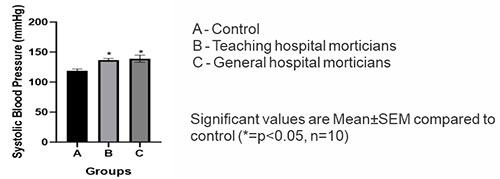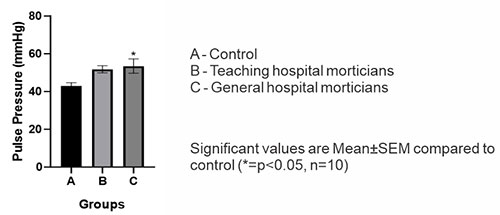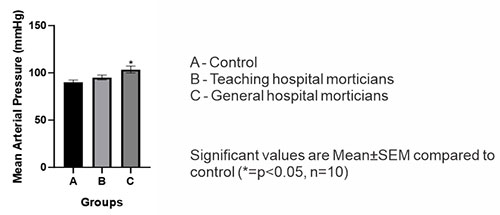A comparative study on some cardiovascular indices among morticians exposed to formaldehyde in Benin City, Nigeria
Ebojele FO, Iyawe VI
Abstract
Background: Some cardiovascular indices among morticians exposed to formaldehyde in a Teaching hospital and General hospital were studied.
Materials and Methods: Thirty subjects were studied and divided into three groups A, B, and C with 10 subjects in each group. Group A served as control with nil exposure to formaldehyde while groups B and C served as the test groups. Subjects in group B were morticians working in the Teaching hospital while subjects in group C were morticians working in the General hospital. Anthropometric measurements were taken and some cardiovascular indices were measured which included pulse rate, systolic blood pressure, diastolic blood pressure, pulse pressure, and mean arterial pressure. Statistical analysis was done using Graph Pad Prism version 8.0.1. Results were presented as Mean ± SEM. Analysis of Variance was used to compare the means of test and control values while post hoc test was done using Tukey’s multiple comparisons test and a P-value of less than 0.05 was considered as statistically significant.
Results: Results revealed significant increase in pulse rate, systolic blood pressure, diastolic blood pressure, pulse pressure, and mean arterial pressure among morticians of the Teaching hospital and General hospital when compared to the control and those of the General hospital morticians were higher compared to the Teaching hospital morticians.
Conclusion: It was therefore concluded that exposure to formaldehyde has deleterious effects on the cardiovascular health of morticians hence, there is an urgent need to seek ways of reducing the atmospheric levels of formaldehyde in our mortuaries in order to protect the cardiovascular health of the morticians.
Keywords: morticians, formaldehyde, Teaching hospital, General hospital, cardiovascular
Introduction
Occupational exposure to formaldehyde has been reported to be high in workplaces such as histopathology laboratories and mortuaries where it is continuously utilized for the fixation of tissues and embalmment of dead bodies.1 Formaldehyde as a chemical fixative prevents tissues from undergoing post-mortem changes which usually occurs after death and this is achieved through its inherent properties that helps to fix and preserve tissues thereby helping to retain the form they held while the individual was still alive.2 The property of formaldehyde in delaying the decomposition of cadavers makes it useful for embalming of bodies in the mortuaries as well as for the purpose of study during anatomy dissections in medical schools. Morticians who work in the mortuaries utilize formaldehyde continuously for the preservation of dead bodies thereby making them prone to high exposure to formaldehyde fumes owing to their occupation. The health hazards of formaldehyde has been reported by several authors3-10 and also several organizations have established standards which defined the limit to which an individual can be exposed to formaldehyde in order to protect occupationally exposed individuals from any possible harmful health effect of formaldehyde which could be acute or chronic. Occupational Safety and Health Administration (USA-OSHA) suggested a Time Weighted Average Concentration of 0.75ppm and Short Term Exposure Limit of 2ppm as legal standards,11 while the American Conference of Governmental Industrial Hygienist (USA-ACGIH) suggested a ceiling limit of 0.3ppm as recommended standard.12 The National Institute for Occupational Safety and Health (USA-NIOSH) suggested a ceiling limit of 0.1ppm and Time Weighted Average Concentration of 0.016ppm as recommended standard,13,14 while the Japan Society for Occupational Health suggested a ceiling limit of 0.5ppm,15 Also in Japan, the Ministry of Health, Labour and Welfare set limit values for environmental exposure to formaldehyde at 0.08ppm as an average for general workplaces and 0.25ppm for specific workplaces like formaldehyde factories and gross anatomy laboratories.16 In a previous study, the present authors investigated the atmospheric levels of formaldehyde in some selected hospital mortuaries in Benin City, Nigeria which included a Teaching Hospital, General Hospital, and a busy Private Hospital mortuary17 where it was observed that the atmospheric level of formaldehyde in the Teaching hospital mortuary was significantly lower compared to the General hospital and Private hospital mortuaries. This present study seeks to investigate the cardiovascular health of morticians in the Teaching hospital mortuary as compared to morticians in the General hospital mortuary.
Materials and methods
Morticians exposed to formaldehyde in the Teaching hospital and General hospital in Benin City, Nigeria were recruited for this study. Subjects were apparently healthy, non-smokers, had no history of cardiopulmonary disease, and had not undergone any recent abdominal or chest surgery. Informed consent was obtained from the subjects who participated in the study while ethical approval was obtained from the College Research Ethics Committee, University of Benin as well as from the Edo State Hospital Management Board before commencement of the work. Subjects were divided into three groups A, B, and C with ten subjects in each group. Group A served as control (non-morticians) while groups B and C served as the test groups respectively. Group B consisted of morticians working in the Teaching hospital while group C consisted of morticians working in the General hospital. Their anthropometric parameters were measured as well as some indices of cardiovascular function which included pulse rate, systolic blood pressure, diastolic blood pressure, pulse pressure, and mean arterial pressure. Statistical analysis was done using Graph pad prism version 8.0.1. Results were presented as Mean ± SEM. Analysis of Variance was used to compare the means of test and control values while post hoc test was done using Tukey’s multiple comparisons test and a p-value of less than 0.05 was considered as statistically significant.
Results
Table 1: Anthropometric parameters of morticians exposed to formaldehyde in the Teaching hospital and General hospital
The results revealed significant increase in pulse rate, systolic blood pressure, diastolic blood pressure, pulse pressure and mean arterial pressure (figures I, II, III, IV and V) among the Teaching hospital morticians and General hospital morticians when compared to the control, and those of the General hospital morticians were higher than those of the Teaching hospital morticians.

Figure I: Mean pulse rate (b/m) of morticians exposed to formaldehyde in the Teaching Hospital and General hospital

Figure II: Mean systolic blood pressure (mmHg) of morticians exposed to formaldehyde in the Teaching Hospital and General H ospital

Figure III: Mean diastolic blood pressure (mmHg) of morticians exposed to formaldehyde in the Teaching Hospital and General Hospital

Figure IV: Mean pulse pressure (mmHg) of morticians exposed to formaldehyde in the Teaching Hospital and General Hospital

Figure V: Mean arterial pressure (mmHg) of morticians exposed to formaldehyde in the Teaching Hospital and General Hospital
Discussion
In a previous study by current authors17 the atmospheric levels of formaldehyde was measured across some selected hospital mortuaries in Benin City and it was reported that the atmospheric level of formaldehyde in the General hospital (4.60ppm) was significantly higher than that of the Teaching hospital (1.13ppm). This was attributed to the fact that the Teaching hospital mortuary was well ventilated and it had air extractors that were functional whereas in the General hospital mortuary the ventilation was poor and they had no air extractors. From the differences in the design and functionality of these mortuaries it was speculated that the health of the morticians in the General hospital mortuary may be more at risk owing to poor working environment. This speculation led to this present study where some indices of cardiovascular function were measured among morticians in the Teaching hospital and General hospital. The result of this present study revealed a significant increase in pulse pressure, systolic blood pressure, diastolic blood pressure, pulse pressure, and mean arterial pressure (figures I-V) of both Teaching hospital morticians and General hospital morticians when compared to the control and those of the General hospital morticians were found to be higher than those of the Teaching hospital morticians. These findings actually suggest that the cardiovascular health of the General hospital morticians that were studied is more at risk than those of the Teaching hospital morticians. The exposure level to formaldehyde in the Teaching hospital mortuary although lower than the General hospital mortuary is still above the recommended standard prescribed by some international organizations that were mentioned earlier. High level of exposure to formaldehyde above the recommended limit is not peculiar to this study alone as some other studies carried out in places where formaldehyde is utilized have equally reported high levels of formaldehyde that were above the recommended ceiling limits.18-21 A lot need to be done in the General hospital mortuary to bring the atmospheric level of formaldehyde to the desired level and also improve on the working environment while the morticians on their own part should adopt measures to reduce their personal exposure by wearing personal protective equipment like plastic gown, facemasks and face shields. They can also reduce the number of hours they spend in the mortuary.
Conclusion
From the findings of this study we therefore conclude that measure should be taken to improve on the working environment of morticians especially those in the General hospital in order to protect their cardiovascular health.
References
- IARC monographs on the evaluation of carcinogenic risks to humans. Vol. 88. Formaldehyde, 2-butoxyethanol and 1-tert-butoxypropan-2-ol. Geneva, Switzerland: International Agency for Research on Cancer 2006; 39-93, 273.
- Farooqui M.Y.H. Formaldehyde. J Appl Toxicol 1983; 3: 264-265.
- Pourmahabadian M, Azam K, Ghasemkhani M. Pulmonary function study between formaldehyde exposed and non-exposed staffs at some of the Tehran educational hospitals. J Med Sci 2006; 6(4): 621-625.
- Wei C.N, Harada K, Ohmori S. Subjective symptoms of medical students exposed to formaldehyde during a gross anatomy dissection course. Int J Immunopathol Pharmacol 2007; 20(2): 23-25.
- Mathur N, Rastogi S.K. Respiratory effects due to occupational exposure to formaldehyde; systematic review with meta analysis. Indian J Occup and Environ Med 2007; 11: 26-31.
- Patil P, Hulke SM, Thakare A. Effect of formalin on pulmonary function: a nine months longitudinal study. Research J of Pharmaceutical Biol and Chem Sci 2012; 3(1): 211-216.
- Shrivastava A, Saxena Y. Effect of formalin vapour on pulmonary function of medical students in anatomy dissection hall over a period of one year. Indian J Physiol Pharmacol 2013; 57(3): 255-260.
- Neginhal R, Herur A, Chinagudi S, Rairam G.B, Kolagi S, Ambi U. Cardiorespiratory effects of acute exposure to formaldehyde in gross anatomy laboratory in medical students- A comparative study. Medica Innovatica 2013; 2(1): 32-35.
- Ebojele F.O, Iyawe V.I. Effect of formaldehyde exposure on some cardiovascular indices among morticians in Benin City, Nigeria. Nigerian Journal of Experimental and Clinical Biosciences 2022a; 10: 15-18.
- Ebojele F.O, Iyawe V.I. Effect of formaldehyde exposure on some pulmonary functions among morticians in Benin City, Nigeria. Annals of Medical and Translational Physiology 2023; 1: 1-4.
- Occupational Safety and Health Administration. Occupational Safety and Health Standards Subpart Z - Toxic and Hazardous Substances Hazard Communication Standard, Code of Federal Regulation, Title 29, Chapter XVII, Part 1910, Subpart Z, Section 1910.1200. The Bureau of National Affairs, Inc., Washington, D.C. 1994.
- American Conference of Governmental Industrial Hygienists (ACGIH). TLVs and BEIs. Threshold Limit Values for Chemical Substances and Physical Agents, Biological Exposure Indices. Cincinnati, OH. 2002.
- NIOSH. Criteria for a Recommended Standard of Occupational Exposure for Formaldehyde. Department of Health, Education and Welfare, Washington, DC. 1976; Pp77-126.
- National Institute for Occupational Safety and Health. Registry of Toxic Effects of Chemical Substances, 1985- 1986.
- Japan Society for Occupational Health. Recommendation for Occupational Exposure Limit (2003 ver.), Formaldehyde. JUOEH. 2003; 46: 147-157.
- Naya M, Nakanishi J. Risk assessment of formaldehyde for the general population in Japan. Regul Toxicol Pharmacol 2005; 43: 232-248.
- Ebojele F, Iyawe V. Formaldehyde air levels in some hospital mortuaries in Benin City. Journal of Anatomical Sciences 2022b; 13(1): 2-5.
- Akbar-Khanzadah F, Vaquerano M.U, Akbar-Khanzadah M, Bisesi M.S. Formaldehyde exposure, acute pulmonary response, and exposure control options in a gross anatomy laboratory. Am J Ind Med 1994; 26: 61-75.
- Tanaka K, Nishiyama K, Yaginuma H, Sasaki A, Maeda T, Kaneko S.Y. Formaldehyde exposure levels and exposure control measures during an anatomy dissecting course. Kaibogaku Zasshi 2003; 78:43-51.
- Ohmichi K, Komiyama M, Matsuno Y, Takanashi Y, Miyamoto H, Kadota T. Formaldehyde exposure in a gross anatomy laboratory-Personal exposure level is higher than indoor concentration. Environ Sci Pollut Res Int 2006; 13:120-24.
- Hafiz OA. Preliminary study: Formaldehyde exposure in laboratories of Sharjah University in UAE. Indian Journal of Occupational and Environmental Medicine 2011; 15(1):33-37.